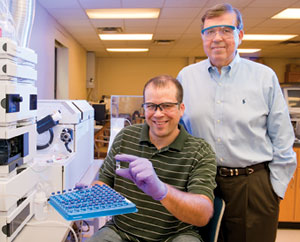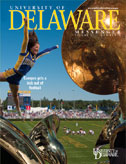Taking a (really) quick look at contaminants

RESEARCH | A chemical reaction can occur in the blink of an eye. Now, researchers are using a new analytical method to pinpoint, at the millisecond level, what happens as harmful environmental contaminants such as arsenic begin to react with soil and water under various conditions.
Quantifying the initial rates of such reactions is essential for modeling how contaminants are transported in the environment and for predicting risks.
The research method, which uses an analytical technique known as quick-scanning X-ray absorption spectroscopy, was developed by a research team led by Donald Sparks, S. Hallock du Pont Chair of Plant and Soil Sciences and director of the Delaware Environmental Institute at UD. The work was reported in the Proceedings of the National Academy of Sciences in September.
Postdoctoral researcher Matthew Ginder-Vogel is the first author of the study, which also involved UD doctoral student Gautier Landrot and Jason Fischel, an undergraduate at Juniata College who has interned in Sparks’ lab during the past three summers.
The research method was developed using equipment at the National Synchrotron Light Source at Brookhaven National Laboratory in Upton, N.Y. The facility is operated by the U.S. Department of Energy.
“This method is a significant advance in elucidating mechanisms of important geochemical processes and is the first application, at millisecond time scales, to determine in real time the molecular scale reactions at the mineral/water interface,” Sparks says. “It has tremendous applications to many important environmental processes including sorption, redox and precipitation.
“My group and I have been conducting kinetics studies on soils and soil minerals for 30 years. Since the beginning, I have been hopeful that someday we could follow extremely rapid reaction processes and simultaneously collect mechanistic information.”
X-ray spectroscopy was invented years ago to illuminate structures and materials at the atomic level. The technique has been commonly used by physicists, chemists, materials scientists and engineers, but only recently by environmental scientists.
“In studying soil kinetics, we want to know how fast a contaminant begins to stick to a mineral,” Ginder-Vogel says. “In general, these reactions are very rapid—90 percent of the reaction is over in the first 10 seconds. Now we can measure the first few seconds of these reactions that couldn’t be measured before. We can now look at things as they happen versus attempting to freeze time after the fact.”
Contamination of drinking water supplies by arsenic is a serious health concern in the United States and abroad. The poisonous element occurs naturally in rocks and minerals and is also used in a wide range of products, from wood preservatives and insecticides to poultry feed.
“Our technique is important for looking at groundwater flowing through minerals,” Ginder-Vogel notes. “We look at it as a very early tool that can be incorporated into predictive modeling for the environment.”
He says one of the best things about the current research is its interdisciplinary nature.
“What’s novel about soil chemistry is that we can take bits of pieces from different fields—civil and environmental engineering, materials science, chemistry and biochemistry—and apply it in unique ways,” he says.
Article by Tracey Bryant





